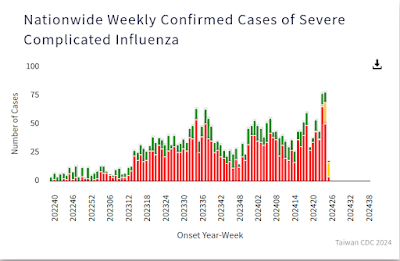#18,149
Unlike Hong Kong, which is famous for having a biphasic `double peaked’ flu season (see Seasonality of Influenza A(H3N2) Virus: A Hong Kong Perspective (1997–2006), Taiwan's flu season usually occurs between November and March in concert with the rest of the Northern Hemisphere.
The last time we saw a heavy summer flu in Taiwan was in 2017 (see Taiwan's Summer H3N2 Epidemic Continues Near Peak), the same year we saw unusual summer flu activity in Hong Kong, Macao, and Southern China (see Macao, Hong Kong & Guangdong Province All Reporting Heavy Flu Activity).
This unusual activity continued during the 2017-2018 Northern Hemisphere flu season, which saw Asia and parts of Europe dominated by Influenza B, while the United States experienced the worst H3N2 flu season - and death toll - since the 1968 pandemic (see CDC: More Than 900,000 Hospitalizations & 80,000 Deaths In Last Winter's Flu Season).
This summer the dominant subtype appears to be H1N1, and with severe cases rising, today Taiwan has announced the release of additional government supplies of antivirals. I'll have a postscript after the break.
Release date: 2024-06-26
The Department of Disease Control and Prevention stated today (26th) that according to epidemic surveillance data, the number of outpatient and emergency visits for influenza-like diseases has been on the rise recently and is in the epidemic period. Monitoring by community contract laboratories in the past four weeks has shown that influenza viruses are mostly type A H1N1. As of June 24, 2012-113, there have been a total of 1,144 severe cases of influenza, including 214 deaths. The number of severe influenza cases and the number of influenza hospitalizations are still high, so the number of publicly funded influenza antiviral drugs (hereinafter referred to as "publicly funded") is once again expanded. The applicable period for the use conditions of "Persons with flu-like symptoms and family members/colleagues/classmates who have flu-like symptoms" is from now until July 31 (as attached).
At present, China's publicly funded pharmaceuticals are deployed in about 4,000 contract medical institutions across the country planned by various county and city health bureaus (for details, please see the CDC global information website https://www.cdc.gov.tw or through the CDC's "Influenza Prevention and Control Network" ”Web page query https://antiflu.cdc.gov.tw/), the configured drugs include Antiflu, Yikama, Suclo and Relenza.
Since influenza may co-circulate with COVID-19 this year, if people have flu-like symptoms, in addition to COVID-19 home rapid screening, if there are danger signs (such as shortness of breath, difficulty breathing, cyanosis, bloody sputum, chest pain, unconsciousness Changes, hypotension, etc.) should seek medical treatment as soon as possible, and the doctor will evaluate whether they meet the conditions for using public-funded drugs based on the chief complaint and clinical judgment. If it is judged that the conditions are met, public-funded drugs can be prescribed without rapid influenza screening. Timing of medication. In addition, since influenza antiviral drugs are currently not included in the health insurance benefit items, the timing and necessity of public drug treatment are still determined by doctors based on the patient's condition and clinical expertise.
The Department of Disease Control and Prevention once again reminds the public not to ignore the seriousness of influenza, and should implement personal hygiene protection measures such as washing hands frequently and paying attention to cough etiquette. Wear a mask when you have respiratory symptoms; cover your mouth and nose with tissue or handkerchief when sneezing, or use a Sleeves instead; when talking to others, try to stay more than 1 meter away. If people have flu-like symptoms, they should seek medical advice nearby and get enough rest. They should wait until they recover before going to school to avoid spreading the virus among peers and causing an epidemic.
For information on the conditions for use of publicly funded pharmaceuticals, the list of contracted medical institutions and information on influenza prevention and control, you can go to the CDC global information website (https://www.cdc.gov.tw) or call the toll-free epidemic prevention hotline 1922 (or 0800-001922) Inquire.appendix
Attachment - List of recipients of publicly funded influenza antiviral drugs.pdf
While what happens this summer in Taiwan, Hong Kong, or the Southern Hemisphere isn't necessarily a harbinger for what we can expect this fall and winter in the Northern Hemisphere, they can sometimes provide valuable clues for what may be coming down the pike.
Right now, we are particularly interested in a growing - but still relatively small number - of reports of oseltamivir resistance turning up in H1N1 (see EID Journal: Multicountry Spread of Influenza A(H1N1)pdm09 Viruses with Reduced Oseltamivir Inhibition, May 2023–February 2024).
Which is why - on top of everything else we're following - we'll be paying particular attention to the course and impact of Taiwan's outbreak over the weeks ahead.
